- Home
- Diane Ackerman
The Human Age: The World Shaped by Us Page 14
The Human Age: The World Shaped by Us Read online
Page 14
Imagine if you woke up one morning and discovered that the restaurants across the street, the nearby deli and groceries—in fact, all your usual food pantries—had moved several hours north during the night. Would you make long tiring shopping trips, change your diet, or follow the food and resettle in the north? Like our hunter-gatherer ancestors, you’d probably pack up and follow the herds. (Our herds may lie motionless on shelves these days, but we’re still out there hunting and gathering.)
The Spanish ornithologist Miguel Ferrer estimates that around twenty billion birds of many species have altered their migration pattern because of climate change. “Long-distance migrators are traveling shorter distances; shorter-distance migrators are becoming sedentary,” he reported at a conference of two hundred migration specialists. “The normal summer temperature in your city twelve months ago is now normal four kilometers further north. It doesn’t sound like a lot, but that’s twenty times quicker than temperatures changed in the last ice age.”
An Audubon Society study found that roughly half of 305 species of North American birds are wintering thirty-five miles farther north than they did forty years ago. The purple finch is wintering four hundred miles farther north. Birds are fun to watch and beautiful, of course, but they’re also essential pollinators, seed dispersers, and insect eaters whom we need to help crops and ecosystems flourish.
It’s not always easy for birds to migrate in our citified, fragmented landscapes. Some species, fooled by warm weather into traveling too early, arrive in new environs before the food is sprouting in the fields. Once upon a time corncrakes filled the skies from northern Europe to South Africa with long-necked speckled charm and hoarse calls, nesting in field edges, or in dense vegetation and grasslands. As we’ve mown those fields to plant crops, corncrakes have lost their foothold and become scarce. Fortunately, through the synchronized efforts of fifty countries, from Belarus to Tasmania—such tactics as asking farmers not to mow their grasslands until after the chicks have fledged—corncrakes and their tottery black young are making a comeback.
There’s often little harm done by nudging plants and animals to new locales. That’s how we (the most successful invasives of all time) came to settle the continents, planting apples, peaches, horses, and roses. Only crab apples are native to North America. The sweet crisp honey-scented apples we wait for all summer, the fleshy Red Delicious we shine on our jeans, and the 7,500 other cultivars, each with its own taste, fragrance, crispness, and uses—all are invasives, and we’ve bred them like show dogs to taste, feel, look, cook, and smell the way we prefer. Since I’m an apple maven, I’m grateful for two old tart apple trees growing in my backyard.
I also find horses a wonderful addition to the North American landscape, even though I know they’re an invasive species that arrived on Spanish ships and adapted to the vast grassy habitats. It’s a mystery how this happened, but if we look at one instance—the wild ponies on the East Coast barrier islands of Chincoteague and Assateague—there are intriguing theories. Did pirates turn horses loose to graze while they were off looting, and return to find they’d vanished into the dense thickets and woods? Did seventeenth-century growers, who imported European horses, decide to pasture them on the island to avoid taxes, and discover that some wandered off to begin a herd? Did a Spanish galleon, bound for the English colonies, encounter a hurricane and break up on the island, where local Indians came to their rescue, but the ponies ran free? Did a boatload of Spanish horses, blinded for work in the mines, sink in a hurricane, and the terrified horses, despite the raging storm and their blindness, somehow manage to swim to shore? No one knows.
The ponies’ ancestors faced poor food, scorching summers and cold damp winters, sandpaper winds, relentless mosquitoes, and cyclical storms. In response they grew thick furry coats and learned a host of survival skills, such as sensing a drop in barometric pressure, seeking shelter in hilly areas, and huddling together with their rumps facing the high winds. As a result, only the fittest and smartest ponies survived, and their genes live on in the current herd, which is vigorous, canny, and well adapted to the rigors of a maritime landscape.
I may be able to trace my beloved rosebushes, which I raise organically, tend minimally, and almost never count, back thirty-five million years to fossils, or five thousand years to the Chinese gardeners who first dreamt of breeding them. They’re not native to North America either, but also highly successful invasives, which ran wild to the surprise and merriment of settlers.
Chinese mitten crabs may be destroying the San Francisco Bay habitat, but European green crabs are helping to revive the ecosystem in the salt marshes of Cape Cod. We’re restoring prairie ecosystems by reintroducing the grasses that used to fan slowly in the summer haze, and reclaiming wetlands by diverting streams and planting native flora. When we do, of course, it changes the climate and the migration patterns of birds and insects; some animals find a new home, while others decamp. In most cases, the ecological restoration is successful, but we sometimes get it wrong.
The southernmost of the Mariana Islands, about 1,500 miles south of Tokyo, Guam has been a U.S. dependency since the Spanish–American War of 1898. People think of it mainly as a military base, but it is also a lush tropical paradise. Yet at dawn all a visitor hears is an eerie silence, no birdsong, because most of the native birdlife has gone extinct. What’s been causing the extinction? Pesticide poisoning? Habitat destruction? Exotic disease? It took scientists years to figure it out. The answer is one pregnant Indonesian brown snake that slithered off a cargo ship in 1949. The nocturnal brown tree snake is an arboreal predator, up to eleven feet long, and poisonous. Equally happy in forests and on rocky shores, today the snake has multiplied into the hundreds of thousands. Birds evolved on Guam with no predatory snakes, and so most of the forest birds have been devoured, along with native reptiles, amphibians, and bats. The flightless Guam rail survives only in captivity, rescued in a last-ditch effort to save the species by starting a captive breeding program on Guam and in some mainland zoos, so that it doesn’t go the way of the Guam flycatcher, a species once unique to the island. Because birds were the chief seed-spreaders of native fruit trees, those are vanishing, too, and the island is aswarm with forty times more spiders, which the missing birds used to hunt.
The same fiddling with evolution can happen on much larger islands. In Australia, cane toads—native to the Americas, from south Texas to the Central Amazon basin—were imported as assassins to eat the plague of cane beetles, which they did with rousing success. In their native habitat, cane toads can grow as big as catchers’ mitts and weigh five pounds. In their new home, they also evolved longer legs to cross the vast outback. Only big-mouthed snakes could swallow the poisonous toads, and those snakes died in the process, leaving their smaller-mouthed, toad-shy cousins to pass on their genes. As a result, Australian snakes began evolving smaller mouths.
Sometimes we breed and move animals around the landscape to save their species from extinction. In Wild Ones, Jon Mooallem writes about his experience with Operation Migration, where endangered baby whooping cranes are hatched in incubators and taught wild crane behaviors, including how to migrate, and then are led thousands of miles by crane-suited humans flying ultralights. “This work,” Mooallem writes, “this wholesale manufacture of wild birds by human beings—turns out to be so ambitious, tedious, and packed with perplexing arcana that, after ten years, it’s hard for those who have given their lives to the project even to agree on how well it’s working and what they should do next.”
Usually, however, we breed and transport animals not to save them but to suit ourselves: domesticating dogs, cats, and even pythons as pets, enslaving horses and oxen for work, or drafting a cavalcade of creatures—from camels and horses to pigeons and bats—to fight beside us in our bloodiest wars.
“THEY HAD NO CHOICE”
When the life-size horse puppet first appears onstage in War Horse, its neck rippling and ears twitching in startlingly lifelike
ways, it takes a moment to figure out what humans are doing inside a see-through horse. But as the puppeteers brilliantly animate the tendons and muscles, it makes sense to the inner shaman inside us, the being who identifies so closely with animals that we’ve embedded animal attributes into our slang (eagle-eyed, stubborn as a mule, lionhearted, strong as a bull, etc.). All children play at being other animals. We often wallpaper nurseries in animal motifs. We use animals as avatars online, and we become part animal in horror movies, not to mention soap operas that feature love-sick half-animal vampires. In the past, we attached our muscles to those of animals, who extended our speed and strength in battle, or carried our supplies. They became a kind of equipment that men often grew fond of, and yet had to watch die in battle, or leave behind at war’s end. As we’ve been learning more about the minds and senses of animals, discovering that they experience emotions similar to our own, we’re developing much more compassion for them.
One moment in the middle of Steven Spielberg’s lyrical epic film version of this story still haunts me. As we are charging through the woods during World War I, amid gunfire, shrieks, and bloodletting, with young men and horses shell-shocked and crazed by horror, the action recedes for a needed break from battle, the camera pauses, and we view the war in a surprising and intimate mirror—reflected on the curved eyeball of Joey, the equine hero. Trauma, like some hallucinogens, lingers for a long time in the tissues, and in that shot one can see exactly how it gets there. Because a horse’s eye is curved, the scene is warped, with men and animals and smoke and balls of light and flying clots of earth leaping in all directions. War is traumatic for horses and other animals—like the humans who create it. The beautifully wrought image says it all, and stings the heart like a line of saber-sharp poetry.
We’ve recruited many unlucky other animals to fight our battles, and only recently have we begun to recognize their capacity for horror and suffering, and to commemorate their sacrifices. Between two busy streets, near Hyde Park, in London, I happened upon a startling war memorial surrounded by a lively crowd of people, several horses and mules, a handful of well-behaved dogs and cats, and a flock of racing pigeons. Older gents in military caps, some in bright regalia from wars long past, displayed medals on their chests and red poppies in their lapels. A mounted Household Cavalry soldier, dressed all in black, rode a matching jet-black Irish horse, which he seemed at times to fade into, except for his white belt and the scarlet stripe down his pant leg and the scarlet band around his cap. Other soldiers in desert camouflage, well-dressed women holding lapdogs, countless veterans, animal rights groups—all milled in admiration around the gleaming sixty-foot curve of white limestone symbolizing the arena of war.
Beautifully rendered in bas-relief on the wall, a parade of camels, elephants, monkeys, bears, horses, pigeons, goats, oxen, and other animals bravely march side by side to war. A few yards away, two heavily laden bronze mules, their strength whittled to the bone, struggle up shallow steps under a burden of rifles and battle equipment, heading toward a breach in the wall. The first mule stretches its arrowlike neck toward a garden visible through the pearly white gates of limestone.
On the other side of the wall, a robust bronze stallion is breaking into a gallop, with a bronze setter beside it, both freed of their burdens. The dog’s head is turned to look back toward fallen comrades. Life’s bas-relief gone, on this side of the wall animals are carved in stark silhouettes and hollowed outlines, like a child’s puzzle waiting for the pieces to be slipped in.
The £1 million memorial, paid for entirely with private funds, bears this legend:
This monument is dedicated to all the animals that served and died alongside British and Allied forces in wars and campaigns throughout time.
A smaller inscription beneath it reads:
They had no choice.
I heard several old soldiers paying tribute to the animals they relied on in so many ways during the war. A veteran sang the praises of the supply mules in the Burmese jungle (their vocal cords had been cut lest they bray and endanger the soldiers). “My life was saved by the mules,” he said, his gaze sliding into the past. “The only way we could get the guns up to us was using them.” Some anonymous animal lover had left a wreath on the memorial whose card read: “You have smelt our fear. You have seen our bloodshed. You have heard our cries. Forgive us dear animals that we have asked you to serve in this way in war.”
Nothing prepares you for how cold the bronze mules are to the touch, or the camel’s sand-matted cement coat. In springtime, beds of daffodils are blooming yellow trumpets. Behind the curve, in the afterlife part of the memorial, the horse is much larger than life, its hooves the size of dinner plates. Too tall to mount, it walks on a lawn of grass sprinkled with tiny daisies. The setter is life-size. Neither has been endowed with a human expression. They are simply and amply animal, healthy and untroubled, relieved of war’s horrors.
Designed by David Backhouse, the memorial poetically captures the plight of the millions of animals who have served and died in our wars. Dogs carried reels on their backs and laid telegraph lines, or ripped their paws raw digging through rubble for survivors. Orca whales became cinematographers, patrolling while holding cameras in their mouths. Pigeons delivered messages from the front. Sea lions dived to 650 feet to recover lost equipment. Beluga whales learned to dial their sonar for surveillance in waters too cold for other mammals to dare. War elephants were ridden on campaign through mountains and jungles. Camel cavalries battled in Arabia and North Africa. And glowworms . . .
Yes, glowworms. In separate chambers of their body, glowworms (also known as lightning bugs) brew luciferin and luciferase, two chemicals that don’t do much until they’re mixed together. Then they become a magic potion that glows so brightly the insects can use it to blink semaphores of love. Their hind ends become literal lighthouses, leading mates to shore. Sometimes “femme fatale” lightning bugs interfere, by mimicking another female’s flash code and stealing her mate. A siren’s come-hither can be mesmerizing, even on the battlefield, and fill the heart of an insect suitor with light or illumine a soldier’s letter from home. Unlike an incandescent bulb, the light blends into the landscape. And so, during the trench warfare of World War I, soldiers of the Somme read their maps and letters by the cold green light of glowworms carried to war as living lamps.
A hundred thousand pigeons flew missions during World War I, and two hundred thousand during World War II, racing a mile a minute to deliver strange cargo—coded notes in capsules taped to their legs. One notable World War I pigeon, Cher Ami, who flew for the U.S. Army Signal Corps (and died of battle wounds in 1919), relayed twelve urgent messages before being shot in the breast and leg. Despite the blood loss, shock, and shattered leg, he delivered his message—an act dubbed “heroic” by the French, who formally awarded him the Croix de Guerre. Trained at Fort Monmouth in New Jersey, and recruited as an avian soldier, Cher Ami could hardly be thought of as “serving his country.” Still, Cher Ami’s one-legged body is on display in the Smithsonian National Museum of American History’s Price of Freedom: Americans at War exhibit.
Stranger by far, at the height of World War II, the Americans prepared Pacific-bound Project X-Ray, also known as the Bat Bomb Project, dreamt up by Lytle S. “Doc” Adams. Bats had always played an important role in U.S. warfare, because bat guano ferments into saltpeter, a key ingredient in gunpowder, and as early as the Revolutionary War soldiers scraped and mined it from caves favored by migrating bats.
Gathering thousands of Mexican free-tailed bats from Bracken Cave, where twenty million mom and baby bats roost between March and October, Adams and his team fitted them with small incendiary bombs, and planned to tuck them into individual canisters, each equipped with a parachute, and drop them over Japan. At a thousand feet the canisters would open and the bats fly free to roost under shingles and eaves, where they would soon explode, setting fire to whole cities dotted with wooden and paper houses. President Roosevelt oka
yed this oddball plan and spent $2 million on it. Then one day armed test bats accidentally escaped and torched a Texas air base, after which Project X-Ray was ditched.
Also at work during those years, the American behaviorist B. F. Skinner began developing a pigeon-guided missile. In what was known as Project Pigeon, he trained the birds to steer by pecking at a target. The U.S. Navy revived it after the war as Project Orcon (for “organic control”), and only abandoned the scheme in 1953 because electronically guided missiles proved more reliable. It wasn’t declassified for another six years, just in case.
It’s well known that pigeons, dogs, horses, camels, and elephants have been drafted for war since ancient days. Apparently pigs served in battle, too. Pliny the Elder, who lived in ancient Rome, tells of herds of grunting hogs being loosed to scare the elephants of invaders. Lately, though, we’ve extended the idea of animal soldiers into the realm of lunacy.
The Pentagon’s Defense Advanced Research Projects Agency (DARPA)—whose “psyops” (psychological operations) division most people first learned of in the book and film The Men Who Stare at Goats—trained CIA operatives to practice remote killing on animals. But that was only one of the CIA’s bizarre plans for animal combatants. In Operation Acoustic Kitty, the CIA implanted a bugging device inside a cat, with an antenna hidden in the cat’s tail. This five-year-long, $5 million Cold War project was canceled when the cat, released near a Russian compound, was hit by a car and died while trying to cross a street. Cats were also considered as guidance systems for bombs dropped on ships (the tenuous logic being that since cats hate water they’d steer the bombs they were strapped to toward the deck).

 A Natural History of Love
A Natural History of Love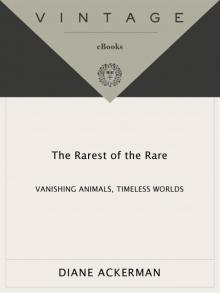 The Rarest of the Rare: Vanishing Animals, Timeless Worlds
The Rarest of the Rare: Vanishing Animals, Timeless Worlds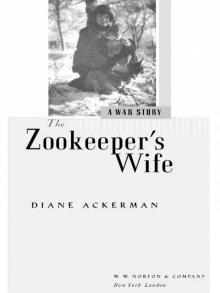 The Zookeeper's Wife: A War Story
The Zookeeper's Wife: A War Story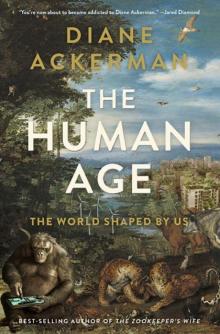 The Human Age: The World Shaped by Us
The Human Age: The World Shaped by Us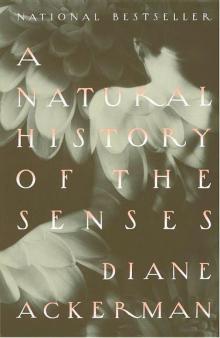 A Natural History of the Senses
A Natural History of the Senses One Hundred Names for Love: A Memoir
One Hundred Names for Love: A Memoir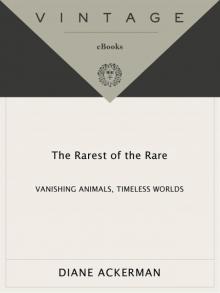 The Rarest of the Rare
The Rarest of the Rare